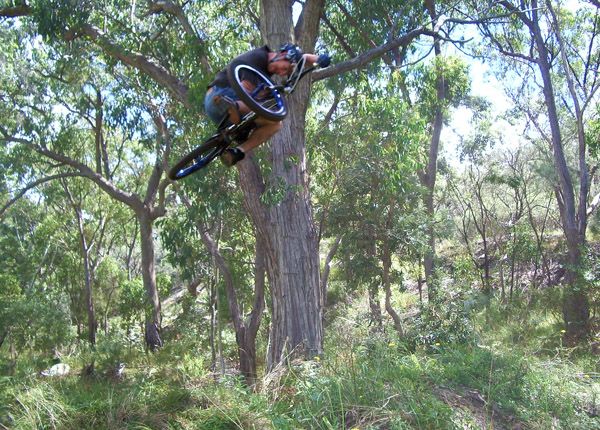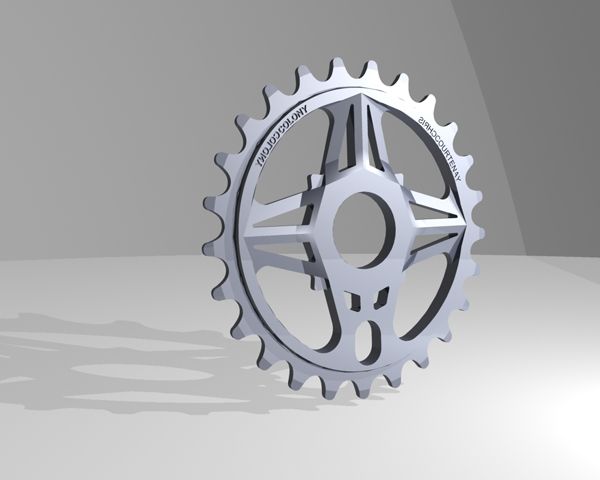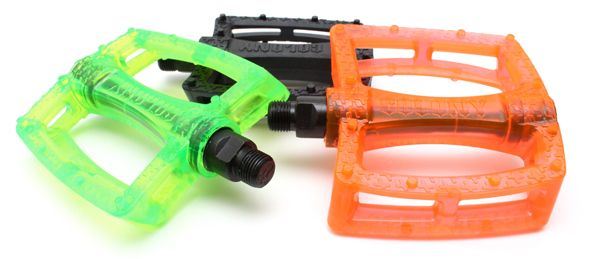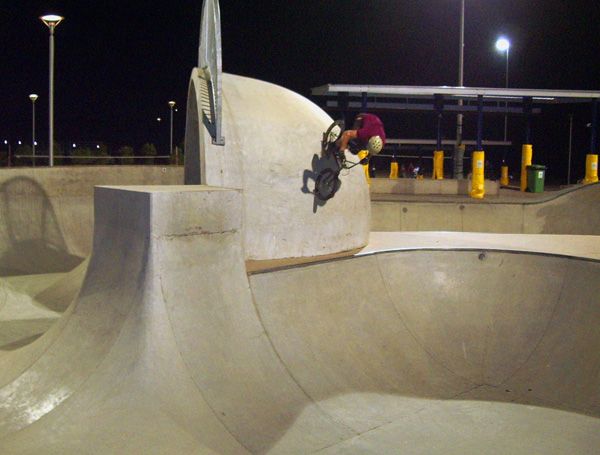
I’m sure some of you are reading this and saying “Who is Mark Matthews-Frederick, and why does he have an interview?”. Well, let me turn it around and ask if you are currently riding any Colony parts? If you are, then you just realized who Mark is. Mark is the man behind product design at Colony, and has had his ideas applied to BMX products for the last five years. Industry is a new interview series that will let you get to know the people behind the scenes helping make BMX what it is from product designers, to brand and team managers, graphic designers, brand owners, web designers and more. So let’s get to know Colony’s Mark Matthews-Frederick a little better…
Name: Mark Matthews-Frederick
Location: I have been living in Brisbane, Australia, but in a couple of weeks will be somewhere in Europe, probably Germany.
Years doing product design: 5 years professionally, 9 including University
Years working for Colony: Almost 5 years
How did you get into product design? What was it that caught your attention about it? Did you go to college or was it something you taught yourself?
When I was young, I always enjoyed drawing – not people or landscapes, but products and “things” like cars, motorbikes, jet planes, etc. As I grew older this passion developed from simply drawing an existing design (of a car or bike), to changing the design to make it look even cooler and work even better. So then, after school, I studied Industrial Design at University (College) – I chose ID, because it is a great combination of applying technical aspects and engineering knowledge, in improving a product’s functionality, manufacturability, all the while trying to make it look as awesome as possible!
Did you ever expect to be working with BMX design or was that the whole reason you got into it in the first place?
I find all design really enjoyable and satisfying, and riding BMX has always been an obsession, so to merge these loves and design bike parts was an ultimate goal. I am so grateful to be part of the BMX scene for work as well as play, but something I really did not expect.
You are the man Clint Millar works with for all of the Colony product design. How did you guys get started working with each other?
A stroke of luck really… I was in Melbourne, Australia on my own for a holiday, when riding a skatepark I got talking to a friendly Spanish guy… And it turned out to be David Quesada from Fly Bikes! I have always admired Fly’s clever ideas and the clean forms of their products, so I was very keen to learn about how David went about design at Fly. I ended up hanging out with David for the week, and helped him a little with some design software, so he returned the favour by posting a story about me and my bike-design aspirations on the Fly Bikes website. By chance, Clint Millar was looking for some design and drafting assistance at the time and happened to stumble across the story. So Clint got in touch with me and I have been working with him and Colony for nearly 5 years now. So I really have to thank David for that initial leg-up into the industry.

What are some of the products you have designed that turned into actual products? Anything you are most proud of?
Almost all of Colony’s products I have had a hand in creating, in different degrees, whether it be full design or just detailing and drafting (i.e. creating the manufacturing drawings) for an idea that Clint has come up with. For most components though, I work together with Clint and our team riders in getting basic ideas down that we would all like to see for a new Colony product. Then I detail the design, ensuring all lengths, thicknesses, bolt sizes, etc. are optimised while looking to minimise weight, remove sharp edges, reduce manufacturing difficulty, etc. I think my favourite part that I have done would be the Official Stem, because even now, several years into its life, I think it still looks quite attractive, is quite light for how strong it is, and I am stoked that most people seem to like it as a product. I am pretty happy with how it turned out, especially when looking back at the first sketch that Guettler and Millar did…

Are you working on anything that you can give us some hints about for Colony?
Well for those that haven’t heard of Chris Courtenay, he is a fellow local from Brisbane, Australia who can really rip the lid off of it on all terrain and has big things coming for him. I have been working on finalizing a signature sprocket design for him, and I think it’s gonna turn out sweet with some interesting 3D contours. Another thing I have been working on lately is a mushroom-style grip – a few of our team riders swear by the mushroom-type, but there are so many similar ones out there already. So before starting design on this, I did a lot of research into all this style of grip on the market now and talked to a lot of people to determine what riders liked and disliked. Then, making subtle alterations on the stock mushroom design to further improve on its ‘good’ features, while also implementing some new ideas and modifying important dimensions to make it stand out from other grips on the market, like the stepped, angular grooves to give it greater grip in multiple directions, regardless of how your hand is positioned on the grip and what trick you are doing.

Do you work for anyone else outside of Colony doing product design or is it a full-time job?
Colony is only part-time for me – there isn’t enough design work to be done to keep me overly busy – or maybe I am just too efficient?… Haha just kidding, my full-time job is as an industrial designer for Bombardier Transportation, we manufacture rail-transport products, so I design interiors and exteriors for passenger trains and trams. Designing trains for Bombardier requires the same goals as when I design bikes – create new solutions that work really well, look great, fun to use (i.e. ride/drive/travel on) and not cost the earth. But I have just decided to move on from Bombardier, to see a bit more of the world and hopefully continue my design career in Europe somewhere. I also do some drafting work for John Buultjens and Pilgrim BMX – I am really excited about Pilgrim, all really quality bikes with awesome bang for your buck.
What’s a typical day like for you? Do you get to have much of a typical day?
On a typical work day, I am in the Bombardier office for normal business hours, probably doing some concept sketching for new trains or 3D-modeling train components (on computer) in preparation for manufacture or for presentation purposes. Hopefully we are not crazy busy at work so I knock off with an hour or two of sunlight to drop into the skatepark or trails on the way home for a quick ride or dig. At night I will spend another hour or two working on a new Colony product – either developing a new idea, 3D modeling or creating 2D drawings for production. I am also into DJing and producing music in my spare time, so if I’m not too knackered I will jump on the decks for a while to spin some house and disco! Then to sleep and dream up some new lines to build at the jumps…
What are some of your tools you work with to get your job done? Do you have any unorthodox ways you go about doing design?
With everything we do, I think all designers constantly (and sub-consciously) have an eye out for new ideas and with every product we use, we think about how we could change it to make it work better, or look cooler. But in terms of tools, quick sketching is probably the most important tool a designer can have – to communicate ideas, and to work through problems and develop form and aesthetic features. 3D modeling computer software (there are multiple programs that I use for different projects and reasons) is another awesome tool to help speed the design process, simulate how forces will act on a product and ensure manufacturing constraints are implemented.
There are a lot of stages when it comes to getting a product to it shipping out to shops and distributors around the world. If you had to pick your favorite part of the process from idea to final product, what would you say you enjoy working on the most?
Definitely the idea-to-manufacture stage – I love taking a product through the entire design process, the evolution from a rough sketched idea to a working 3D computer-model and set of manufacturing drawings is really exciting. Also, any time I am out riding somewhere and I see another rider with a product I have designed on their bike, I feel like giving myself a little high-five!

How do you go about coming up with new products? Do you have any places you look for inspiration?
Usually with Colony it goes something like this: Clint has a bike part in mind that he wants to develop (e.g. a brake lever), we put our heads together and research the existing levers out there already, discussing the good and bad features of all the levers we can think of. We then take a bit of time to brainstorm new ideas and new ways of trying to solve problems riders are having with their levers. This is the time when I look across many different industries for inspiration – it could be from anywhere, like high-performance materials found in other sporting goods, precision manufacturing processes from the medical industry, dramatic styling treatments given to sports cars… the list goes on.
Do you ever take advantage of the prototypes and get some of your own testing in?
Absolutely! I like to push the boundaries with my designs, to maximise performance, lower weight, and other ideas to break away from the norm; so when we get prototypes made I am always eager to test the products out and see how things perform. Sometimes these initial prototypes work great, sometimes the design needs a little tweaking and sometimes, things just don’t quite work the way I had envisaged. But luckily this has been pretty rare so far, and most importantly is the lessons we have learned from these ‘failed’ prototypes.
What’s the best part about your job?
When I design anything, including both trains and BMX parts, I really enjoy thinking ‘outside the square’ and pushing the boundaries as to what is normal and accepted for products in current markets. So then if Colony or Bombardier decide to take a chance and put my new idea or new approach on the market, and it pays off with people (riders, users, the public) loving the product, its just an awesome feeling.
What’s the worst part about your job?
When I don’t get the opportunity to carry a design right through the design process. A product’s development doesn’t always progress smoothly, manufacturers will often have different opinions on how things should be made, or suppliers will try and cut corners to make a product easier for them to make. Occasionally, for one reason or another, I haven’t had any contact with manufacturers after my initial design has been done – I haven’t been able to check samples, investigate changes or propose alternatives to modifications that manufacturers are making. So without industrial design input throughout the process, one ‘minor’ change often has monumental effects on a product’s function, or leads to a final product that has lost the magic of the initial design.
It sounds like you have a trip to Germany coming up. Care to share why you are going there? How long do you plan on being there and will you still be working for Colony abroad?
I haven’t really been traveling outside Australia much at all, so I think now is the time – and Europe sounds like a great place to start! And from everything I have read, and everyone that I have spoken with, Germany sounds right up my alley – cool people, good BMX scene, good music scene, opportunities (hopefully) for design work, not to mention tasty beers! Thanks to the internet, continuing design for Colony shouldn’t be a problem and I would love to keep working with Clint, for as long as he wants me! I have managed to sort out a work Visa for Germany but haven’t got a full-time design job lined up, and I don’t really know anyone over there, so fingers crossed I can make some friends and find a company that could benefit from using my skills.

I’m sure there are a lot of people out there that would love to do what you do. Care to give some advice on the steps somebody should take to get into product design?
Industrial design is highly creative, but is also very technical and involves a lot of it computer use these days, so to be a well-rounded product designer, education is essential to learn about things like usability, ergonomics, materials, manufacturing processes, environmentalism, stress and fatigue… It is very rewarding, though getting a start in the design industry is tough, and as much of a cliché as it is, hard work really does pay off if you want something bad enough. And I believe hard work somehow has a habit of bringing good luck too!
Is there anything I missed you would like to say?
I would like to say a big thanks to Clint Millar and Cooper Brownlee at Colony for being great to work with and especially Clint, for giving me a chance in the beginning, and an opportunity to break into my dream career. Thanks to Brett Davidson and everyone I have been working with at Bombardier for all the good times and for everything that I have learnt. Also thanks to David Quesada at Fly Bikes and John Buultjens at Pilgrim for their support, and all of the BMX companies out there who are creating original products with good design. And of course, a huge thank-you to my amazing family and friends for their encouragement and friendship, particularly my brothers, as I will really miss the good times riding with them and constant laughs while I am overseas.
